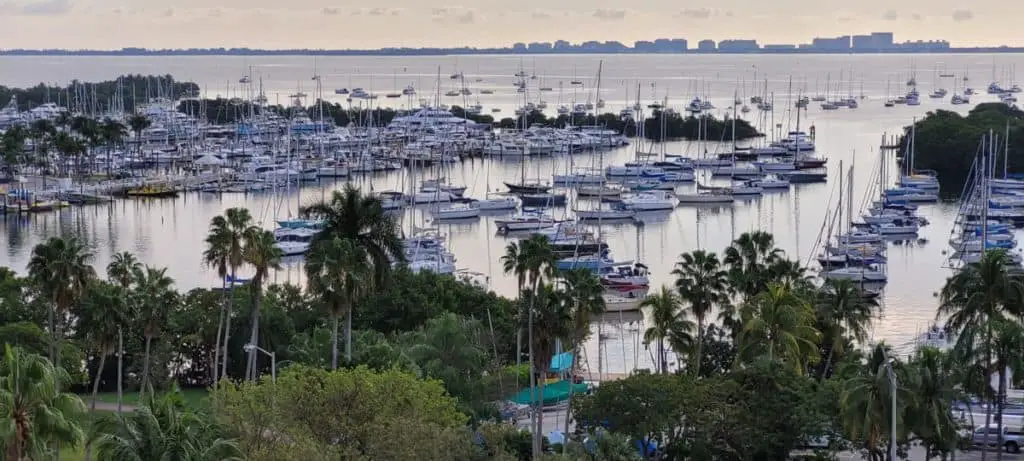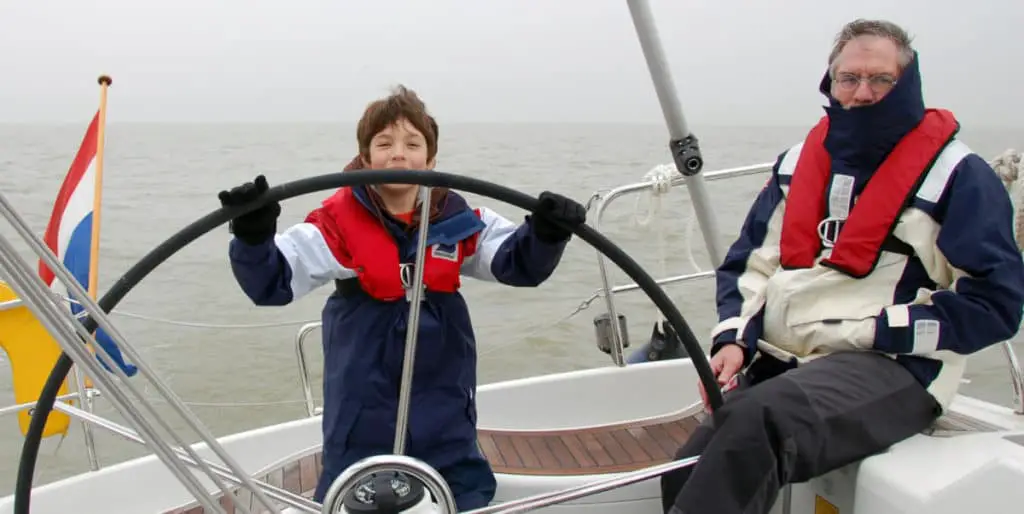As an Amazon Associate, we earn from qualifying purchases. We may also earn commissions if you purchase products from other retailers after clicking on a link from our site.
I started out sailing by buying a boat and asking friends how to do it, this way of learning (or not learning) got me grounded on rocks, into storms and wasn’t really the best way to learn. It was very cheap though, but how much does it cost to learn to sail in a more safe and effective way?
The cost of learning to sail a catamaran is somewhere around X USD to learn the basics, X USD to be able to coastal sailing, and X USD to proficiently sail across oceans. Locations and the need for certifications will impact price.
The rest of this article details the cost of sailing lessons in different areas of the world and different skill levels. It also explains what accreditation you might need and the cost of obtaining that. If you’re ready to get sailing, keep reading!
Learning To Sail in Different Areas

Like anything else, the cost of sailing lessons varies based on your geographic location. In the United States, $25 an hour is the typical cost of sailing lessons, but the prices change depending on what state you’re in.
In Northern California, the price of sailing lessons is around $25 an hour, whereas in Southern California, the lessons are usually $18-$20 per hour. Lessons can cost $30 or more per hour on the East Coast. In Florida, lessons are usually around $20 per hour.
In addition to the area you’re learning to sail in, the price can also change with the day of the week. Because most people can only go to lessons on weekends, the cost of these lessons is higher than weekday lessons.
Learning to Sail as a Complete Beginner

If you are a complete beginner, you’ll need a basic course to get some experience before hitting the water.
The best basic sailing courses include a textbook and materials. These courses usually last around three days, with around 20 hours of instruction over those three days. For the classes, book, and materials, you can expect to pay around $900.
Most of these courses also include practice sessions with an instructor to prepare you for your first sail. This means you’ll be ready when you hit the water on your own for the first time.
Another way to get basic skills is to crew a vessel. You can ask your friends, family, and acquaintances who have catamarans if you can help them out on their next cruise. If you’re bold, you can ask around a marina to see if anyone needs an additional crew member. This is usually free of charge, except that you will of course offer something in return for their help.
I like to learn at my own pace so online courses fit me pretty good, you can get two free courses with NauticEd here (they also have catamaran specific courses)
Crew members are occasionally hard to come by, so you may find that finding a spot is easier than you’d expect. If you have a passion for learning and are willing to work hard, most experienced sailors will take you on. However, this method does not give you the accreditation that going through a proper course will.
Although it is by far the most adventurous and fun way I have tried.
Accreditation for Sailing a Catamaran
Something you’ll need to consider when learning how to sail is what kind of accreditation you’ll need. This depends on where you live and where you’d like to sail.
Some countries don’t require any kind of accreditation, but if you’d like to charter a sailboat abroad, you’ll need some sort of certificate.
If you are struggling to figure out whether or not you need a certificate or license, then I suggest you check out this article When do I need a license?
A basic sailing certification from the ASA or US Sailing that allows you to sail between 25 and 35 feet (7.62 and 10.66 meters) in moderate winds can cost $300-$1,000. If you’d like to learn outside of the United States, the International Certificate of Competence is recognized by 24 countries.
Additional certifications, such as Celestial Navigation ($125), Coastal Skipper Advanced ($225), and VHF ($50), will add costs to any lessons you pursue.
I would also recommend you check out other cheap ways of learning to sail, more on that here.
How to Keep Learning Catamaran Sailing
Now that you’re past your first sailing and you’re not a complete beginner, you can choose to aim a little higher. You don’t have to become an expert, but if you want to keep learning, here are the three levels of proficiency you can expect to reach.
1. First Sail to Weekend Sailor
If you want to sail on your own on shorter coastal trips, you’ll need further instruction. Intermediate courses instruct you on how to cruise safely in local waters with moderate weather conditions and on-the-water skills you need.
In these courses, you’ll master the basic skills that you already know and learn more about sail trim, emergency procedures, anchoring techniques, navigation skills, and maintenance.
In a shoulder season, an intermediate sailing course that lasts five days will usually cost around $1,200.
2. Weekend Sailor to Blue Water Cruising
If the Caribbean is calling your name, you’re not done yet! Advanced sailing courses usually have prerequisites and require previous certification, but if you’ve got that and you’re ready for more, these courses are the best way to know your stuff and be able to go on longer trips.
I didn’t take any courses like this before going from Miami to Bimini but that doesnt mean I dont think it is very useful, to be honest, I kind of wish that we had more experience before we left.
Advanced courses like these typically last a week. Many involve staying on a vessel for that time and going on a trip with the instructor. Because of the added element of accommodation and food, the cost of these lessons can be pretty high.
For example, a course of this type that leaves out of Fort Lauderdale costs $4,000.
3. Blue Water Cruising to Circumnavigation
If you want to go above and beyond and do a major ocean crossing, you’ll need to become an expert. Circumnavigation can be daunting, and there is much to think about and plan for.
Some people have completed circumnavigations with no formal training and have simply learned along the way. While this is admirable, it’s not always recommended. Sailing is dangerous, especially circumnavigation, so taking some additional lessons isn’t a bad idea.
There is a difference between things going good because you are proficient and things going good because you are lucky. You can’t do much about luck, but you should always try to improve your skillset.
Expert courses instruct you on advanced navigation, maintenance, night passages, offshore sailing, and celestial navigation.
Advanced courses at reputable schools cost approximately $6,000 for two weeks of instruction aboard a vessel, with accommodation and meals included.
Are Catamarans Better Than Monohull (Classic Sailboats)?
Catamarans are typically safer and easier to sail than monohull sailboats, and they offer more living space and storage space. Because they have two hulls, catamarans are more stable than monohulls.
Catamarans also have two engines, so you’re not at a complete loss if you have a problem with one engine. Catamarans also have extra room, which gives you space to move around the boat. There’s also more living space, making them great for longer trips.
If a cat is better or not is mainly dependent on what you’ll be using it for, to learn more I suggest you read this Catamaran vs Monohulls which is best for you?.
Here are Some of My Favorite Catamaran Cruising Resources
Thank you for reading this article. I hope you found it helpful as you hopefully start your sailing adventures. Here are some resources that I use as a sailor that I hope you’ll also find helpful. These are affiliate links, so if you do decide to use any of them, I’ll earn a commission. But in all honesty, these are the exact things that I use and recommend to everyone, even my own family.
Sailboats: If you’re looking for the best boat to suit your needs, I would recommend a catamaran. If you’re interested, I can show you the differences between catamarans and other types of sailboats.
Books: For getting started, I really like Cruising catamarans made easy. It is actually a textbook from the American sailing association; it is used to get a cruising catamaran certification. There are some other great books, and I have compiled a list of books about cruising catamarans that you will find useful.
Communication: Being out on adventures, whether it be sailing or climbing mountains, good communications are essential to being safe. I recommend two things Google fi (incredibly simple cellular data all over the world) and Garmin inreach mini (for text and voice in remote areas without cell coverage)
Sailing courses: Online sailing courses are great for beginners starting out their sailing career; it’s an efficient way of learning the basics of navigation, throttle controls, and maritime safety. I suggest starting with two free courses from NauticEd.
To see all my most up-to-date recommendations, check out this resource that I made for you!

